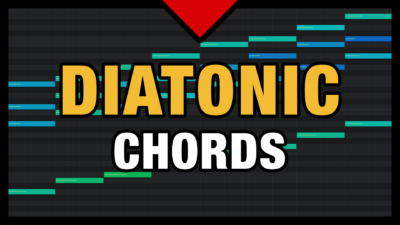 Diatonic chords, are all chords that only uses notes from within the scale of your song. So for example, let’s say we use the A minor scale to write your song in. Well, that scale uses only the white keys on the keyboard.
Diatonic chords, are all chords that only uses notes from within the scale of your song. So for example, let’s say we use the A minor scale to write your song in. Well, that scale uses only the white keys on the keyboard.
So, then the diatonic chords will also only use notes from the white keys. Now a standard scale has 7 notes + the added octave of the root note to end the scale. So if you play all white keys from A to A, you just played the A minor scale, right?
Well, each key I played has a number that is basically its placement within the scale, called scale degree. The root note, which is A in this case, is called 1, the next, B is called 2, and so on up to 7 which is G. Before the scales ends with the A an octave above the root note.
Now to be precise, in music theory you use Roman numerals to state the scale degree of each note or chord, like this: I, II, III, IV, V, VI, VII. Those are the 7 degrees of a standard scale in music.
This means that you have 7 diatonic chord to choose from, if you use only simple triads. You can get even more if you extend your chords or add color to them, by either adding notes, or altering notes within the chord by pushing them up or down. So, for the A minor scale, which uses only white keys, you get these diatonic triad chords:
- I – A minor
- II – B diminished
- III – C major
- IV – D minor
- V – E minor
- VI – F major
- VII – G major
Let’s look at this sequence carefully, because I want you to remember it well. Why? Because the great thing about scale patterns and diatonic chords for the scale, is that it is the same for ALL keys of the specific scale type. So for this example, we used the natural minor scale. So whenever you compose music within this scale, you get the diatonic chords sequence in the same order. Which means that I can simply delete the keys from the same pattern, like this:
Diatonic Chords for the Minor Scale
- I – minor
- II – diminished
- III – major
- IV – minor
- V – minor
- VI – major
- VII – major
..and simply name this pattern: Natural minor scale – Diatonic Chords.
Now let’s do the same thing, but for all Major scales. Then we get this diatonic chord pattern:
Diatonic Chords for the Major Scale
- I – Major
- II – minor
- III – minor
- IV – Major
- V – Major
- VI – minor
- VII – diminished
Congratulations! You have now unlocked the secret to choosing chords that sound right. Diatonic chords. Of course, the sequence of the chords matter a lot, and some chord changes will always sound more natural than others. But basically, the diatonic chords is a great starting point as a bank of chords to choose from when creating your chord progression.
I want to give a final bonus advanced tip as well. Did you notice that both the minor scale type, and Major scale type, both have a diminished chord in the diatonic chord pattern?
Well, I can honestly tell you that diminished chords are rarely used. Mainly because they have the dreaded tritone interval inside the chord, which is very dissonant.
So knowing that, I would say you can focus mainly on 6 chords as the starting point in your chord progression. And don’t forget, you can also add notes to extend the triads into chords with more than 3 notes. Or alter notes within the chord, to for example make a suspended chord.
To truly learn this…I have another practice activity for you. I want you to write down these diatonic chord patterns for the Major Scale, and minor scale. Because writing things down helps the learning process. But not only that, I then want you to look at your notes, as you play through the chords of each of these patterns.
Let’s say you start with the C Major Scale – Diatonic Chords. Well, then start by choosing the key, I recommend you use the C Major scale first. And then play each diatonic chord of the scale going up, then going down. Then switch key, but use the same scale type. Let’s say D Major.
Pick out the diatonic chords of D Major using the Diatonic Chord Formula you just learned. And play them in a sequence going from 1 to 7, and 7 to 1. After you have practiced this for a while, start mixing things up. Switch randomly between the degrees of the scale. From 1 to 6…to perhaps 3, then 5, and so on.
The purpose of this exercise is for you to become familiar with the sound and character of the diatonic chords of the specific scale type. And also, to develop an instinct for how different chord changes sound like. Because going from 4 to 1, has a totally different emotion than going from 3 to 6 for example.
After you practiced this a lot, you will find that you will know beforehand what a specific chord change will sound like in your chord progression. This will speed up your composing process, and give you much more creative power. Have fun developing your chord changing instinct! =)

